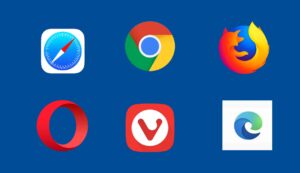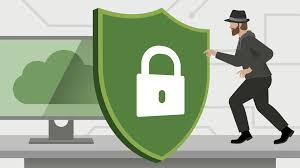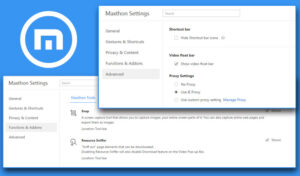In today’s digital age, many of us spend a significant portion of our lives online. Yet, how often do we pause to assess the security settings of our web browsers before diving into the vast ocean of the internet? Whether you prefer Microsoft Edge, Mozilla Firefox, Google Chrome, Brave, Maxthon, or any other browser, these tools have become indispensable in both our professional and personal endeavours. Each day, we rely on them to connect with others and navigate through countless websites.

Given the pivotal role that web browsers play in facilitating our daily transactions—be it for work or leisure—it’s crucial to ensure that the browser you choose is as secure as possible. In this discussion, we will delve into various security options available across different web browsers. However, it’s essential to note that enhancing your browser’s security may sometimes come at a cost: certain functionalities on specific websites might be affected. For instance, if you disable JavaScript for safety reasons, some sites may not operate correctly. Likewise, denying access to your camera or microphone could hinder video conferencing applications from functioning correctly. Additionally, some websites might require extensive data collection about your online habits in order to work effectively (for tips on safeguarding your personal information online).
![]()
So why should you care about these web browser security settings? Your web browser serves as your primary gateway to the Internet; many applications depend on it—or its components—to operate smoothly. This underscores the significance of configuring your browser’s security settings thoughtfully. While numerous web applications aim to enrich your browsing experience by introducing various features and functionalities—many of which may seem appealing—it’s wise to approach them with caution. Often, these features are unnecessary and can expose you to potential threats.
A prudent strategy is to turn off most features unless you’ve determined they are essential for a specific task or site you’re visiting. If you come across a website that appears reputable and trustworthy after careful consideration, feel free to enable those features while you’re using it temporarily—and promptly turn them off once you’re done.
As we navigate this digital landscape together—where convenience often dances with caution—it becomes increasingly important not only to enjoy our time online but also to protect ourselves while doing so. By being proactive about our browser’s security settings and understanding their implications on functionality and safety alike—we can enhance not just our browsing experience but also safeguard our personal information against unwanted intrusions.
In the vast digital landscape, navigating the intricacies of web browser security settings can feel like embarking on a treasure hunt, with each browser offering its unique map. Picture yourself seated at your computer, ready to embark on this quest for safety and privacy online.

As you open Maxthon or Google Chrome, your eyes are drawn to the familiar sight of three little dots clustered together in the top right corner of your screen—an ellipses button that holds the key to your browser’s hidden treasures. With a click, you unveil a menu filled with options; selecting Settings… feels akin to opening a door into a new realm. From there, you venture into the Privacy and Security tab, where various settings await your careful adjustment.
But wait! If you’re using Firefox instead, the journey takes on a different path. Should you have enabled the menu bar—a nostalgic feature reminiscent of earlier computing days—you would navigate by clicking Tools and then selecting Options. If you’re using a more modern version without that bar, simply tapping on those three horizontal lines at the top right will do just as well; from there, you’ll find either Options or Settings, depending on your version. Once inside this sanctuary of choices, it’s time to explore further into the “Privacy & Security” tab, where you’ll encounter various security levels: Standard, Strict, or Custom.

Each browser is like its own kingdom, with distinct rules and configurations for security options. To truly master these realms, you must familiarise yourself with their unique menus—perhaps even consulting their help features or delving into resources provided by their creators online. As you sift through these guides and explanations, it becomes clear that understanding terminology is crucial; knowing what each term signifies empowers you to evaluate which features best suit your needs.
Now comes an important question: How do you determine what level of security is right for your web browsing experience? Ideally, you’d want to set everything to its highest possible level—a fortress against potential threats lurking in cyberspace. Yet, be mindful that tightening security may inadvertently prevent certain websites from loading correctly or functioning as intended.
Thus, an effective strategy arises: adopt that maximum level of protection but remain flexible enough to enable specific features only when necessary for particular tasks or sites. This way, you’re not just safeguarding yourself but also ensuring that your online adventures remain smooth and enjoyable.
So here you are—a digital explorer equipped with knowledge about web browser security settings—ready to traverse the internet safely while maintaining control over how much access different sites have within your secure fortress!

What do the various terms signify? Different web browsers employ distinct terminology, but here are some standard terms and options you might encounter:
Zones
Many browsers allow users to categorise websites into specific segments or zones, enabling them to set varying security protocols for each category. For instance, Internet Explorer classifies its zones as follows:
– Internet Zone: This is the default zone encompassing all publicly accessible websites. To ensure optimal protection while browsing, it’s advisable to configure your security settings to the highest level; at a minimum, maintaining a medium setting is recommended.
– Local Intranet Zone:In environments like offices that feature their intranet, this zone includes internal web pages. While this zone is optional, it can be beneficial if you manage several websites yourself or if your organisation operates multiple sites. Even with a sense of trust in these internal resources, exercise caution by not lowering security levels for external sites; an attack on them could inadvertently compromise your safety as well.
Restricted Sites Zone: You can flag websites that raise concerns about their safety and implement stricter security measures. However, even with enhanced settings in place, it’s wise to steer clear of any sites that leave you questioning their safety altogether.
In navigating this digital landscape, understanding these terms and how they apply can significantly enhance your online protection.

Many websites utilise web scripts, particularly JavaScript, to enhance their visual appeal and functionality. However, it’s essential to be aware that these scripts can also be exploited for malicious purposes (for further details, refer to Browsing Safely: Understanding Active Content and Cookies). Similarly, programs like Java and ActiveX controls are designed to create or run active content that adds certain features. However, they can also expose you to potential risks (again, see Browsing Safely: Understanding Active Content and Cookies for more insights).
To bolster your web browser’s security, the right plug-ins can make a significant difference. Often, browsers require additional software, known as plug-ins, to unlock extra functionalities. There are several options available to enhance your security measures:

Firstly, managing cookies is crucial for improving your browser’s safety. You can disable, limit, or permit cookies based on your needs. A prudent approach is to turn off cookies initially and then enable them selectively when visiting trusted sites that necessitate their use.
Another effective strategy is enhancing your browser’s security by blocking pop-up windows. While enabling this feature might limit some website functionalities, it significantly reduces the influx of pop-up ads—many of which could be harmful. Major browsers such as Firefox and Chrome offer various applications or add-ons like uBlock Origin and NoScript that you can install to secure your browsing experience further.
Lastly, consider using different web browsers tailored for specific tasks as a protective measure against online threats. For instance, choose one browser with standard settings for banking and sensitive transactions while opting for a more secure browser equipped with tighter restrictions for general browsing or shopping activities.
By implementing these strategies thoughtfully, you can navigate the internet with greater confidence and safety.

Maxthon
In today’s fast-paced digital world, the importance of protecting your online banking information cannot be overstated, especially when utilising a browser like Maxthon. Imagine navigating through the vast expanse of the internet, where every click could either lead you to a treasure trove of information or expose you to potential threats. To embark on this journey safely, it all starts with laying down a solid foundation: crafting strong passwords for your banking accounts.
Picture this: your password is like a fortress guarding your financial kingdom. It should be intricate and one-of-a-kind, weaving together uppercase and lowercase letters, numbers, and special characters into an elaborate tapestry that is nearly impossible for anyone else to decipher. Steer clear of using easily guessed details such as birthdays or names of beloved pets; instead, think outside the box and conjure up unpredictable combinations that would stump even the most determined intruder.

As you prepare to enter this realm of online banking, consider fortifying your defences further by activating Two-Factor Authentication (2FA). This clever mechanism acts as an additional shield; each time you attempt to log in, you’ll receive a verification code sent directly to your mobile device or email. This step not only bolsters your security but also serves as an effective deterrent against unauthorised access—an invaluable safeguard in an age where cyber threats lurk at every corner.
Equally crucial is ensuring that your Maxthon browser remains up-to-date. Think of updates as the armour that protects you from emerging dangers; regularly checking for new versions can mean the difference between safety and vulnerability. These updates often contain essential security patches designed to guard against newly discovered weaknesses in software.
Moreover, maintaining cleanliness in your digital footprint is vital—regularly clearing out browsing history, cache files, and cookies can prevent hackers from exploiting remnants left behind during previous sessions. Just imagine walking through a crowded marketplace with valuable goods while leaving behind breadcrumbs for thieves; it’s best not to leave any traces at all.
For those moments when you’re engaged in online banking activities and wish for heightened privacy, Maxthon’s privacy mode comes into play like a cloak of invisibility. It allows you to browse without storing any sensitive data from past visits, providing peace of mind as you navigate through financial transactions without worrying about leaving behind critical information.
Lastly, don’t underestimate the power of reputable security extensions or antivirus software explicitly tailored for online safety. Adding these tools can serve as additional layers of protection against potential threats lurking within cyberspace.
By taking each precaution seriously—from creating complex passwords to utilising advanced security features—you significantly enhance how securely you manage sensitive financial transactions in our interconnected world. With every step forward on this journey toward digital safety, you’re not just protecting yourself; you’re building a resilient fortress around your financial well-being amidst an ever-evolving landscape filled with both opportunities and risks.
